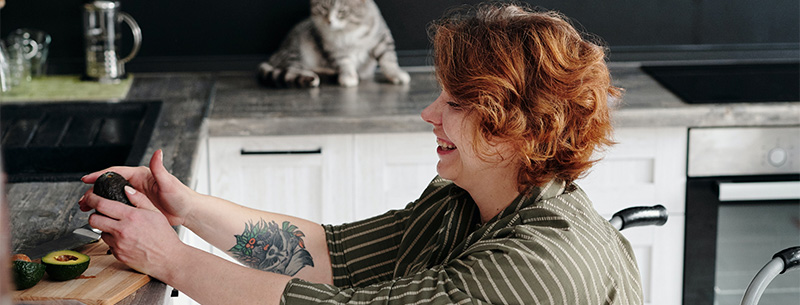Cooking can be loads of fun and is an important part of self-care. Preparing your own food can help you become more independent – and even more importantly, give you greater choice about what you eat.
Today, we’re sharing our top hacks for cooking so you can be safe, organised and take advantage of the many NDIS supports available to help you in the kitchen.
1. Spend time setting up your kitchen.
Setting up your kitchen well is important for any cook but even more so if you have restricted mobility, low vision or difficulty handling standard kitchen equipment.
Here are some ideas for setting up a kitchen that’s right for you (and rental property friendly):
- If standing at a kitchen bench is not achievable, consider whether a stool, adjustable bench, bench on wheels or wheelchair table might do the job
- Ensure everything you need is easy to access
- Use hooks, rails or a pegboard to hang items used regularly
- Store commonly used spices, oils and sauces next to the stove
- Use benchtop storage such as shelving or tiered racks if you have trouble accessing cupboards or drawers.
2. Plan your menu.
Being organised can really make a difference when you’re cooking. Planning includes thinking ahead about what you’re going to make and checking you have all the ingredients.
If you lead a busy life, try creating a weekly menu plan using a whiteboard or a meal planning app such as Mealime or Yummly.
If you’re new to cooking, start with something healthy and simple that you love to eat – the Eat for Health website is a great place to start!
3. Prepare everything in advance.
Before you begin cooking, review your recipe or think in advance about what you’re going to make.
- Read a new recipe all the way through so you know the steps in advance
- Start with a clean kitchen. Wash any dirty dishes and clear the drainboard or dish rack.
- Peel and chop vegetables and set them aside first
- Measure accurately, especially if you’re trying a new recipe
- Get out the main pots, pans and utensils you will need before you start cooking.
4. Be safety aware.
Always wash your hands with soap and water before you start preparing food, and after handling any raw meats.
Following the below tips will help keep you safe in the kitchen:
- Don’t leave food cooking on the stove unattended
- Never cook in loose or flammable clothing
- Invest in pan holders to prevent pans from tipping over on the stove (especially if you’re using a gas cooktop)
- Turn pot and pan handles towards the back of the stove
- Use different utensils for raw and cooked foods
- Have dedicated chopping boards for different types of foods (especially meat).
5. Take advantage of assistive technology.
If your goals relate to learning to cook or being more independent in the home, you may be able to use your NDIS funding to purchase assistive technology for the kitchen.
Some useful items include:
- Cutting devices like knife guards, angled knives and slicing guides
- Custom cutting boards with high contrast for low vision, or boards with adjustable pegs to hold items in place while you chop
- Specially designed peelers and utensils
- Reminder gadgets such as touch button timers, timers on cords and boil alerts
- Jar, can and bottle openers
- Custom kettles and kettle tippers so you can make a cup of tea or coffee safely
- Non-slip mats (very helpful for chopping and mixing).
Top tip: Most of the items above fall into the low cost assistive technology category. That means if your need for them is reasonable and necessary and you have funding for assistive technology in your NDIS Plan, you should be able to purchase them without a quote (up to $1500).
Other NDIS supports.
If you have set a goal to learn how to cook, a range of other NDIS-related supports may be available to help you to become more independent and confident in the kitchen.
For example, it may fund a support worker to help you learn how to plan, prepare and cook your meals.
It may fund an occupational therapist to help you to develop strength and coordination, or identify assistive technology that can help you in the kitchen.
Be sure to talk about your goals at your next NDIS Plan meeting so you get all the supports you need.
What about the Leap in! app?
The Leap in! app? can help you create, track and share your home cooking goals. Use the Goal section to track your progress and to prepare for your next NDIS Plan meeting.
If you would like to find out more, call the Leap in! Crew on 1300 05 78 78, contact us via our website (online chat available), email crew@leapin.com.au or sign up to Leap in! plan management today.
Further reading
Food for thought: Meals and the NDIS.

